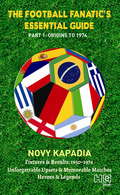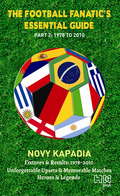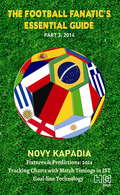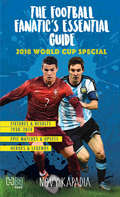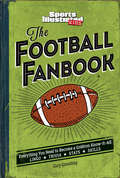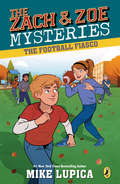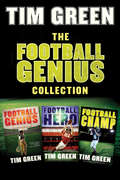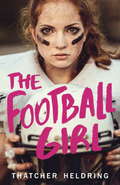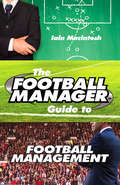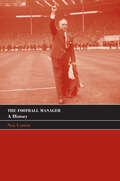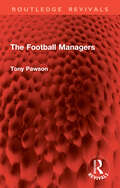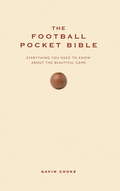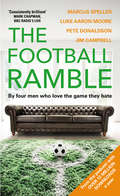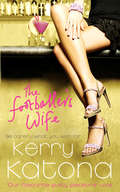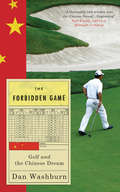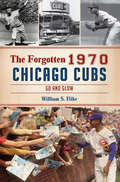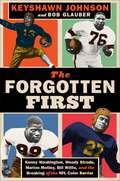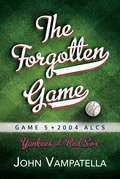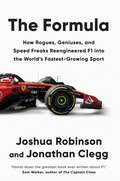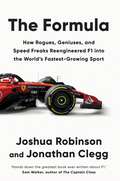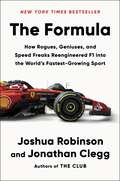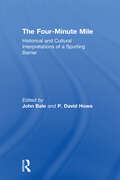- Table View
- List View
The Football Fanatic's Essential Guide Part 1: Origins to 1974
by Novy KapadiaFootball is not just a beautiful game, but a global obsession. Every four years, football kicks off a frenzy with every match, every player and every goal being analysed with fervour and recorded with vigour. This essential guide is a companion volume for every football-crazy fan who wants facts, statistics and data right on hand. The Football Fanatic?s Essential Guide is jam-packed with important and fascinating information on international matches and players, and India?s role in football history. Put together by reputed sports broadcaster and columnist Novy Kapadia ? one of India?s foremost football experts ? this compendium is invaluable for every passionate enthusiast of this legendary game.
The Football Fanatic's Essential Guide Part 2: 1978 to 2010
by Novy KapadiaFootball is not just a beautiful game, but a global obsession. Every four years, football kicks off a frenzy with every match, every player and every goal being analysed with fervour and recorded with vigour. This essential guide is a companion volume for every football-crazy fan who wants facts, statistics and data right on hand. The Football Fanatic?s Essential Guide is jam-packed with important and fascinating information on international matches and players, and India?s role in football history. Put together by reputed sports broadcaster and columnist Novy Kapadia ? one of India?s foremost football experts ? this compendium is invaluable for every passionate enthusiast of this legendary game.
The Football Fanatic's Essential Guide Part 3: 2014
by Novy KapadiaFootball is not just a beautiful game, but a global obsession. Every four years, football kicks off a frenzy with every match, every player and every goal being analysed with fervour and recorded with vigour. This essential guide is a companion volume for every football-crazy fan who wants facts, statistics and data right on hand. The Football Fanatic?s Essential Guide is jam-packed with important and fascinating information on international matches and players, and India?s role in football history. Put together by reputed sports broadcaster and columnist Novy Kapadia ? one of India?s foremost football experts ? this compendium is invaluable for every passionate enthusiast of this legendary game.
The Football Fanatic's Essential Guide: 2018 World Cup Special
by Novy KapadiaThe definitive companion to the 2018 World Cup Every four years, football kicks off a frenzy with every match, every player and every kick being analysed with fervour and recorded with vigour. This essential handbook is the perfect volume for every footballcrazy fan who wants facts, statistics and data right on hand. The Football Fanatic's Essential Guide for 2018 is jam-packed with fascinating facts on international matches and players since the World Cup began. Put together by reputed sports journalist, columnist and commentator Novy Kapadia, this compendium of football facts will score with every passionate enthusiast of the beautiful game. PLUS - 100 quiz questions to test your football quotient - All the stats you need from 1930 to 2014 - Tracking charts for 2018 matches
The Football Fanbook (A Sports Illustrated Kids Book): Everything You Need to Become a Gridiron Know-It-All
by The Editors of Sports Illustrated KidsSo you've become a football fan and now you want to take your passion for the game to the next level? Then The Ultimate Football Fan Handbook is just what you need. Filled with fun facts to dazzle your friends, important numbers and milestones, the unique lingo of the game, the strategies that teams employ, and much, much more, this book will have its readers sounding like experts and dazzling their friends with their knowledge.
The Football Fiasco (Zach and Zoe Mysteries, The #3)
by Mike LupicaThe third installment of the Zach and Zoe Mysteries--a sports-themed chapter book mystery series by New York Times bestselling author Mike Lupica.There's nothing eight-year-old twins Zach and Zoe Walker love more than playing sports and solving mysteries. And when those two worlds collide . . . well, it doesn't get any better than that. In their third mystery, Zach and Zoe discover their recess football has been completely deflated, leaving them without a ball to play with. But who's behind it? By searching for clues around the school, Zach and Zoe uncover the truth behind the damaged ball, and learn the importance of friendship, inclusion, and being conscious of other people's feelings. Ending with a big Walker Family Thanksgiving Turkey Bowl game, The Football Fiasco is the perfect fall chapter book!In the opening installments of the Zach and Zoe Mysteries, bestselling author Mike Lupica begins a series for a new and younger audience, introducing readers to a sports-loving detective duo who can swing for the fences and catch the culprit in one fell swoop. With a recipe equal parts sports and mystery, the Zach and Zoe Mysteries break fresh ground for an author who has been called the greatest sportswriter for kids.
The Football Genius Collection
by Tim GreenThe thrilling Football Genius books--by former pro football player Tim Green--are perfect for middle-grade readers, and this collection contains three bestselling novels in the series.Football Genius: Troy White can predict any football play before it happens. And when his single mom gets a job with the Atlanta Falcons, Troy knows it's his big chance to help them out of their slump--and finally prove his football genius. But unless Troy can convince star linebacker Seth Halloway that he's telling the truth, the Falcons' championship--and Troy's mom's job--are in serious jeopardy.Football Hero: Ty Lewis can't believe it when Coach V recruits him for the football team. This is Ty's big chance to prove how fast he is on the field, get a fresh start in a new school, and be like his older brother, Thane "Tiger" Lewis, who's about to graduate from college--and is being courted by the NFL. But Ty's guardian, Uncle Gus, won't let him play. Uncle Gus needs Ty to scrub floors and toilets for his cleaning business while he cooks up gambling schemes with the local mob boss, a man called "Lucy."Football Champ: When Troy White proved his remarkable "football genius" to the Atlanta Falcons, they brought him on board as a team consultant. Now, thanks to Troy's ability to predict winning plays, the Falcons are pulling in victories. Then Troy's perfect world comes crashing down. Reporter Brent Peele is out to smear as much mud on the Falcons as he can, and that means going after Troy.
The Football Girl
by Thatcher HeldringFor every athlete or sports fanatic who knows she's just as good as the guys. This is for fans of The Running Dream by Wendelin Van Draanen, Grace, Gold, and Glory by Gabrielle Douglass and Breakaway: Beyond the Goal by Alex Morgan. The summer before Caleb and Tessa enter high school, friendship has blossomed into a relationship . . . and their playful sports days are coming to an end. Caleb is getting ready to try out for the football team, and Tessa is training for cross-country. But all their structured plans derail in the final flag game when they lose. Tessa doesn’t want to end her career as a loser. She really enjoys playing, and if she’s being honest, she likes it even more than running cross-country. So what if she decided to play football instead? What would happen between her and Caleb? Or between her two best friends, who are counting on her to try out for cross-country with them? And will her parents be upset that she’s decided to take her hobby to the next level? This summer Caleb and Tessa figure out just what it means to be a boyfriend, girlfriend, teammate, best friend, and someone worth cheering for.“A great next choice for readers who have enjoyed Catherine Gilbert Murdock’s Dairy Queen and Miranda Kenneally’s Catching Jordan.”—SLJ “Fast-paced football action, realistic family drama, and sweet romance…[will have] readers looking for girl-powered sports stories…find[ing] plenty to like.”—Booklist “Tessa's ferocious competitiveness is appealing.”—Kirkus Reviews “[The Football Girl] serve[s] to illuminate the appropriately complicated emotions both of a young romance and of pursuing a dream. Heldring writes with insight and restraint.”—The Horn Book
The Football Manager's Guide to Football Management
by Iain MacintoshThe Football Manager Guide to Football Management is for anyone who has ever believed that they could do a better job than their club’s manager. It’s for anyone who has ever tried to prove that point by taking the hot seat in the management simulation Football Manager. Whilst most Football Manager players feel they possess innate tactical awareness, on point man-management skills and a gift for dealing with the media; even the most hardened fan would have to admit there’s much to be learned from those who ply their trade in the real world. If you want to make an immediate impact on your struggling hometown club, you need to refer back to Sir Bobby Robson. If you want to lay down the law with your young players, you need to take tips from Sir Alex Ferguson. Want to avoid a financial catastrophe? Then learn from Leeds United!So if, at any point in your life, you have imagined yourself in a tracksuit, waving your arms in the air on the touchline, with your perfect XI scribbled on the back of a beer mat and thinking ahead to the press conference, then this book is for you. After all, you’re already a football manager… you just haven’t been appointed yet.
The Football Manager: A History (Sport in the Global Society)
by Neil CarterThis clear and accessible book is the first in-depth history of the role of the football manager in British football, tracing a path from Victorian-era amateurism to the highly paid motivational specialists and media personalities of the twenty-first century. Using original source materials, the book traces the changing character and function of the football manager, covering: the origins of football management – club secretaries and early pioneers the impact of post-war social change – the advent of the football business television and the new commercialism contemporary football – specialisation and the influence of foreign managers and management practices the future of football management. The Football Manager fully explores the historical context of these changes. It examines the influence of Britain's traditionally pragmatic and hierarchical business management culture on British football, and in doing so provides a new and broader perspective on a unique management role and a unique way of life.
The Football Managers (Routledge Revivals)
by Tony PawsonThere are few posts more dramatic, more controversial, or more public than a football Manager’s. The pressures of success, and failure; the problems of finance and business management; the challenge of tactics and training: these are just some of the issues which Tony Pawson examines in this book, originally published in 1973.He not only traces the development of the Manager from a minor figure to a dominating status – with portraits of those who had most strongly influenced the managerial revolution, from Chapman to Cullis and Busby – but also draws vividly the personalities and methods, the aims and achievements, of the leading Managers of the time, including giants like Stein and Shanky, Revie, Mercer, Nicholson and Clough. He discusses too the role of our National Team Managers, new developments in medical treatment, scouting and transfers, the strategies and techniques of the Managers not only of all the most powerful clubs in Great Britain but of those struggling for survival or recognition.In this entertaining book, Tony Pawson, who had written on the game for twenty years, and had himself played to First Division standard, presented an acutely observed, highly literate, and absorbing account of football management in all its aspects.With football managers still a topic of public interest today, this is a great opportunity to look back at the history of the role.
The Football Pocket Bible
by Gavin CookeThe perfect gift for every football fanWhen was the first World Cup held? Which football team has the smallest ground? And what exactly is the Cruyff turn? Find the answer to all these and more inside The Football Pocket Bible, a compendium of football trivia and titbits about the world's most popular sport. Inside, debate the tactics and the transfers, the teams and the triumphs, defend the clubs, the competitions and the kits and indulge in the books, the films and the infamous songs. You'll also find practical information like the best pubs for away supporters, how to explain the offside rule and even how to set up a grassroots football club. This pocket guide will answer all your football questions, from the lowest attendance record to the highest wages paid to a footballer. Find out about memorable World Cup moments, the history of the Premier League, as well as the Bosman ruling and the Hillsborough disaster. Whether you're a seasoned supporter or a budding football fanatic, whether your favourite football film is Bend it Like Beckham or The Damned United, The Football Pocket Bible is guaranteed to entertain and enlighten every lover of the beautiful game. So if you want all the football facts at your fingertips, kick back and climb to the top of the league with The Football Pocket Bible today.You won't need any substitutes."Pro football is like nuclear warfare. There are no winners, only survivors." Frank Gifford"Some people think football is a matter of life and death. I assure you, it's much more serious than that." Bill Shankly"There is only one word to describe football and that is 'if only'" Bobby Robson"Football and cookery are the two most important subjects in this country" Delia SmithThis beautiful hardback edition has both dust-cover and gold embossing on the spine making it the perfect gift. Every Pocket Bible is lovingly crafted to give you a unique mix of useful references, handy tips and fascinating trivia that will enlighten and entertain you at every page. There is a Pocket Bible for everyone...Other titles in the series: The Rugby Pocket Bible, The Camping Pocket Bible, The Cricket Pocket Bible, The Dad's Pocket Bible and The DIY Pocket Bible.
The Football Pocket Bible
by Gavin CookeThe perfect gift for every football fanWhen was the first World Cup held? Which football team has the smallest ground? And what exactly is the Cruyff turn? Find the answer to all these and more inside The Football Pocket Bible, a compendium of football trivia and titbits about the world's most popular sport. Inside, debate the tactics and the transfers, the teams and the triumphs, defend the clubs, the competitions and the kits and indulge in the books, the films and the infamous songs. You'll also find practical information like the best pubs for away supporters, how to explain the offside rule and even how to set up a grassroots football club. This pocket guide will answer all your football questions, from the lowest attendance record to the highest wages paid to a footballer. Find out about memorable World Cup moments, the history of the Premier League, as well as the Bosman ruling and the Hillsborough disaster. Whether you're a seasoned supporter or a budding football fanatic, whether your favourite football film is Bend it Like Beckham or The Damned United, The Football Pocket Bible is guaranteed to entertain and enlighten every lover of the beautiful game. So if you want all the football facts at your fingertips, kick back and climb to the top of the league with The Football Pocket Bible today.You won't need any substitutes."Pro football is like nuclear warfare. There are no winners, only survivors." Frank Gifford"Some people think football is a matter of life and death. I assure you, it's much more serious than that." Bill Shankly"There is only one word to describe football and that is 'if only'" Bobby Robson"Football and cookery are the two most important subjects in this country" Delia SmithThis beautiful hardback edition has both dust-cover and gold embossing on the spine making it the perfect gift. Every Pocket Bible is lovingly crafted to give you a unique mix of useful references, handy tips and fascinating trivia that will enlighten and entertain you at every page. There is a Pocket Bible for everyone...Other titles in the series: The Rugby Pocket Bible, The Camping Pocket Bible, The Cricket Pocket Bible, The Dad's Pocket Bible and The DIY Pocket Bible.
The Football Ramble
by Jim Campbell Marcus Speller Luke Moore Pete Donaldson The Football Ramble LimitedDownloaded over ten million times a year the Football Ramble podcast has established itself as the essential, independent voice of football punditry. The weekly podcast has resonated with supporters around the world and their sold-out live shows have been a massive hit.This book is a collaboration from all four presenters and will tackle the real issues from fans you won’t see or hear on Sky Sports, or anywhere else for that matter.From the weird and wonderful, from the Alan Pardew to the Kevin Keegan, the Ramble has it covered. Putting all aspects of the game under the microscope, this book is a timely reminder of why we just can’t take our minds off football.
The Footballer's Wife
by Kerry KatonaOn the surface of it glamour girl Charly Metcalfe finally has it all. She's officially a W.A.G, having bagged premiership footballer Joel Baldy to be her boyfriend - and she has the lifestyle to go along with the title. She lives in a million-pound penthouse. She gets invited to the most glamorous parties, and Joel will buy her anything she wants. But behind closed doors, life as a footballer's other half isn't as perfect as it seems. Joel has a temper and when he and Charly argue he lets his fists do the talking. Charly knows she should get out but there's one problem...she loves him. In fact she loves him enough to marry him in spite of their problems - and her own family's objections. But having married in haste, is Charly going to regret her decision all too quickly...?
The Foraging Spectrum: Diversity in Hunter-gatherer Lifeways
by Robert L. KellyKelly (Anthropology, U. of Wyoming) describes the remarkably complex structures and practices of foraging cultures, such as those in which members store up good will to tide them over the times they cannot hunt or gather. After a solid introduction to the place of foraging societies in anthropology and anthropological theories about environment and evolution from an point of view, Kelly considers a range of aspects of foraging societies, describing studies on mobility, sharing and exchange, land tenure, group size and reproduction, the roles of men and women, egalitarian and non-egalitarian hunter-gatherers, and of the probable systems of foraging in prehistory. Percheron Press is the reprint imprint of Eliot Werner Publications. Annotation ©2007 Book News, Inc., Portland, OR (booknews.com)
The Forbidden Game
by Dan WashburnIn China, just because something is banned, doesn't mean it can't boom... Statistically, zero percent of the Chinese population plays golf, still known as the "rich man's game" and considered taboo. Yet China is in the midst of a golf boom - hundreds of new courses have opened in the past decade, despite it being illegal for anyone to build them. Award-winning journalist Dan Washburn charts a vivid path through this contradictory country by following the lives of three men intimately involved in China's bizarre golf scene. We meet Zhou, a peasant turned golf pro who discovered the game when he won a job as a security guard at one of the new, exclusive clubs and who sees himself entering the emerging Chinese middle class as a result; Wang, a lychee farmer whose life is turned upside down when a massive, top-secret golf resort moves in next door to his tiny village; and Martin, a Western executive maneuvering through China's byzantine and highly political business environment, ever watchful for Beijing's "golf police." The Forbidden Game is a rich and arresting portrait of the world's newest superpower and three different paths to the new Chinese Dream.
The Forbidden Game: Golf And The Chinese Dream
by Dan WashburnIn China, just because something is banned, doesn't mean it can't boom. . . Statistically, zero percent of the Chinese population plays golf, still known as the "rich man’s game" and considered taboo. Yet China is in the midst of a golf boom -- hundreds of new courses have opened in the past decade, despite it being illegal for anyone to build them. Award-winning journalist Dan Washburn charts a vivid path through this contradictory country by following the lives of three men intimately involved in China's bizarre golf scene. We meet Zhou, a peasant turned golf pro who discovered the game when he won a job as a security guard at one of the new, exclusive clubs and who sees himself entering the emerging Chinese middle class as a resuThe Forbidden Game is a rich and arresting portrait of the world’s newest superpower and three different paths to the new Chinese Dream.
The Forgotten 1970 Chicago Cubs: Go and Glow (Sports)
by William S. BikeA month-by-month history of an underappreciated season that will bring back memories for Chicago baseball fans—includes photos. Chicago Cubs fans always will remember the beloved 1969 team. Yet the 1970 Cubs are, in many ways, more interesting. The Cubs added fascinating characters like Joe Pepitone and Milt Pappas to the legendary nucleus of Billy Williams, Ron Santo, and Ernie Banks. The team came closer than in any year between 1945 and 1984—finishing only five games out of first place in one of baseball&’s hottest pennant races. Offering a fast-paced look at the season month by month, William S. Bike moves beyond wins, losses, and statistics to relive Ernie Banks's 500th home run, the addition of &“the basket&” to the outfield walls, and other iconic moments from a landmark year at Wrigley Field.
The Forgotten First: Kenny Washington, Woody Strode, Marion Motley, Bill Willis, and the Breaking of the NFL Color Barrier
by Keyshawn Johnson Bob GlauberThe unknown story of the Black pioneers who collectively changed the face of the NFL in 1946.THE FORGOTTEN FIRST chronicles the lives of four incredible men, the racism they experienced as Black players entering a segregated sport, the burden of expectation they carried, and their many achievements, which would go on to affect football for generations to come.More than a year before Jackie Robinson broke the color barrier in Major League Baseball, there was another seismic moment in pro sports history. On March 21,1946, former UCLA star running back Kenny Washington—a teammate of Robinson's in college—signed a contract with the Los Angeles Rams. This ended one of the most shameful periods in NFL history, when African-American players were banned from league play.Washington would not be alone in serving as a pioneer for NFL integration. Just months after he joined the Rams, thanks to a concerted effort by influential Los Angeles political and civic leaders, the team signed Woody Strode, who played with both Washington and Robinson at UCLA in one of the most celebrated backfields in college sports history. And that same year, a little-known coach named Paul Brown of the fledgling Cleveland Browns signed running back Marion Motley and defensive lineman Bill Willis, thereby integrating a startup league that would eventually merge with the NFL.THE FORGOTTEN FIRST tells the story of one of the most significant cultural shifts in pro football history, as four men opened the door to opportunity and changed the sport forever.
The Forgotten Game: Game 5 2004 ALCS Yankees at Red Sox
by John VampatellaA gripping detailed recap of the wildly insane, oft-overlooked, extra-innings classic that turned the 2004 ALCS into the most memorable playoff series in modern history.No team had ever come back from a 3–0 deficit to win a postseason series in baseball. In the history of MLB postseason play going into Game 5, there had been twenty-five series to start out 3–0. Of those, twenty ended in sweeps, two made it to a sixth game, and none had made it to a seventh game. The Forgotten Game details one of the greatest games in baseball history between the two most bitter rivals in the sport. For years the two teams fought for American League supremacy, with the Yankees usually coming out on top. Following an incredible 2003 playoff series, the two teams squared off again in 2004 for the right to go to the World Series. The Yankees won the first three games in convincing fashion, and it seemed, yet again, they would eliminate the Red Sox…until Boston miraculously won Game 4. Most fans remember the steal by Dave Roberts that sparked the game-tying rally in the ninth to keep Boston&’s hopes alive. And most fans remember Curt Schilling&’s sutured ankle in Game 6. But Game 5 was a do-or-die moment for the Red Sox, and they delivered in epic fashion. Yet, despite being the pivotal game in the series, it hasn&’t drawn the attention the others have. The Forgotten Game breaks down Game 5 on a virtual pitch-by-pitch basis, from the battle between Pedro Martinez and Mike Mussina, to the clutch performances by Tim Wakefield and David Ortiz, while breaking down the strategies the managers employed, and stories of how various players made their way to their respective teams for that fateful night. Never before has the story of Game 5 been told in such vivid and riveting detail. &“If you&’ve devoured everything Red Sox-Yankees you&’ll LOVE IT. If you are new to the rivalry and era you will understand it for the first time. I couldn&’t put it down and loved the historical context of each inning. I loved it.&” —Gar Ryness (Batting Stance Guy) &“While most people remember Boston's dramatic game 4 victory or Curt Schilling's bloody sock heroics in game 6, game 5 was truly the unsung hero of the series. John Vampatella does a magnificent job of explaining why while providing tremendous background and anecdotes that all baseball fans will enjoy. The Forgotten Game is an absolute must for Red Sox fans of all ages!&” —Scott Cordischi, WEEI sports talk show host
The Formula: How Rogues, Geniuses, and Speed Freaks Reengineered F1 into the World's Fastest-Growing Sport
by Joshua Robinson Jonathan Clegg'HANDS DOWN THE GREATEST BOOK EVER WRITTEN ABOUT F1.' -Sam Walker, author of The Captain Class'MODERN F1 IS THE SPORTS STORY OF THIS ERA AND NO ONE COULD TELL IT BETTER' -Kevin Clark, ESPN'THE FASTEST READ YOU WILL EVER PICK UP' -A.J. Baime, author of Go Like HellF1 is now the fastest growing sport in the world; the full story of its unbelievable rise is a riveting saga only hinted at by the likes of Drive to Survive. In this book - the first, definitive account of how F1 came to achieve total global fandom - Wall Street Journal reporters Joshua Robinson and Jonathan Clegg take us inside a world full of racing obsessives, glamorous settings, petrolheads, engineering geniuses, dashing racers and bitter rivalries.The story of F1's world dominance is one of near-constant transformation and experimentation. This is a sport where the only way to win championships is to land a series of technical moon shots - and then do it all over again. With fast cars, big money, beautiful people, and glamorous locations from Monaco to Melbourne, The Formula tells the full, epic story of the sport. Starting in 1950s Britain, where six years of wartime engineering laid the foundations for a new type of motorcar racing; to the first global star partnership of Senna and Ecclestone; Spygate; Crashgate and its transition into an entertainment juggernaut. Bringing unique insight and access to F1's most storied teams and personalities - from Ferrari to Lewis Hamilton to Christian Horner and Daniel Ricciardo -The Formula offers a riveting portrait of the drivers, corporations, cars, rivalries, and audacious gambles that have shaped the sport for half a century.The end result is a high-octane history of how modern F1 racing came to be - the first book to tell the story of the outrageous successes and spectacular crashes that led F1 to this extraordinary yet precarious moment. More than just a sports story, it is the tale of a commercial empire, one built in the 20th century, rendered almost obsolete in the early 21st, and re-emerged world-dominant today; a disrupter that claimed its place in the crowded sports marketplace through cash, personality, and a new understanding of what a sport needs to be in the age of wall-to-wall entertainment.
The Formula: How Rogues, Geniuses, and Speed Freaks Reengineered F1 into the World's Fastest-Growing Sport
by Joshua Robinson Jonathan Clegg'HANDS DOWN THE GREATEST BOOK EVER WRITTEN ABOUT F1.' -Sam Walker, author of The Captain Class'MODERN F1 IS THE SPORTS STORY OF THIS ERA AND NO ONE COULD TELL IT BETTER' -Kevin Clark, ESPN'THE FASTEST READ YOU WILL EVER PICK UP' -A.J. Baime, author of Go Like HellF1 is now the fastest growing sport in the world; the full story of its unbelievable rise is a riveting saga only hinted at by the likes of Drive to Survive. In this book - the first, definitive account of how F1 came to achieve total global fandom - Wall Street Journal reporters Joshua Robinson and Jonathan Clegg take us inside a world full of racing obsessives, glamorous settings, petrolheads, engineering geniuses, dashing racers and bitter rivalries.The story of F1's world dominance is one of near-constant transformation and experimentation. This is a sport where the only way to win championships is to land a series of technical moon shots - and then do it all over again. With fast cars, big money, beautiful people, and glamorous locations from Monaco to Melbourne, The Formula tells the full, epic story of the sport. Starting in 1950s Britain, where six years of wartime engineering laid the foundations for a new type of motorcar racing; to the first global star partnership of Senna and Ecclestone; Spygate; Crashgate and its transition into an entertainment juggernaut. Bringing unique insight and access to F1's most storied teams and personalities - from Ferrari to Lewis Hamilton to Christian Horner and Daniel Ricciardo -The Formula offers a riveting portrait of the drivers, corporations, cars, rivalries, and audacious gambles that have shaped the sport for half a century.The end result is a high-octane history of how modern F1 racing came to be - the first book to tell the story of the outrageous successes and spectacular crashes that led F1 to this extraordinary yet precarious moment. More than just a sports story, it is the tale of a commercial empire, one built in the 20th century, rendered almost obsolete in the early 21st, and re-emerged world-dominant today; a disrupter that claimed its place in the crowded sports marketplace through cash, personality, and a new understanding of what a sport needs to be in the age of wall-to-wall entertainment.
The Formula: How Rogues, Geniuses, and Speed Freaks Reengineered F1 into the World's Fastest-Growing Sport
by Joshua Robinson Jonathan CleggAn NPR Best Book of 2024A Sports Illustrated Best Book of 2024NEW YORK TIMES BESTSELLERWall Street Journal reporters and authors of The Club, Joshua Robinson and Jonathan Clegg tell the riveting saga of how Formula 1 broke through in America, detailing the eclectic culture of racing obsessives, glamorous settings, gearheads, engineering geniuses, dashing racers, and bitter rivalries that have made F1 the world’s fastest growing sport.For decades in America, car racing meant NASCAR, and to a lesser extent IndyCar, with Formula 1—the wealthiest racing league in the world—a distant third. Fast forward to 2023, and F1 has emerged at the front of the pack powered by a passionate yet nascent American fanbase. The F1 juggernaut has arrived, but this checkered flag was far from inevitable.In The Formula, Wall Street Journal reporters Joshua Robinson and Jonathan Clegg tell the epic story of how F1 saved itself from collapse and finally conquered America through guile, fearlessness, and above all, reinvention. With fast cars, big money, glamorous locales, and beautiful people as the backdrop, The Formula reveals how F1’s sudden arrival in the US was actually decades in the making, a product of the sport’s near-constant state of transformation and experimentation. Bringing unique insight and access to F1’s most storied teams and personalities—from Ferrari to Bernie Ecclestone to Christian Horner to Lewis Hamilton—The Formula offers a riveting portrait of the drivers, corporations, cars, rivalries, and audacious gambles that have shaped the sport for half a century.The end result is a high-octane history of how modern F1 racing came to be—the first book to tell the story of the outrageous successes and spectacular crashes that led F1 to this extraordinary yet precarious moment. More than just a sports story, The Formula is the tale of a disrupter that broke into the crowded American sports marketplace and claimed its place through cash, personality, and a new understanding of what a sport needs to be in the age of wall-to-wall entertainment.
The Four-Minute Mile: Historical and Cultural Interpretations of a Sporting Barrier
by John BaleBreaking records and challenging the limits of human ability are central to much of our understanding of athletic track and field sports, with a world record title arguably as valued as an Olympic gold medal. Some particular limits and records take on greater significance, however, as in the case of the Four-Minute Mile which was roundly believed to be impossible until Roger Bannister shattered the illusion with half a second to spare in May 1954. These essays look at the background of Bannister’s achievement and the meaning that was ascribed to it by the media and the public at large, drawing on an array of interdisciplinary and international influences to unpick the legend surrounding an historic moment in our social and sporting past.
